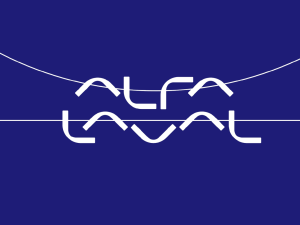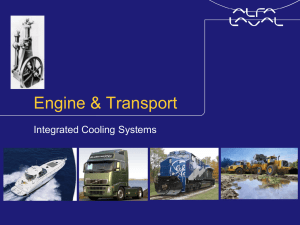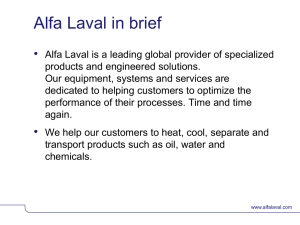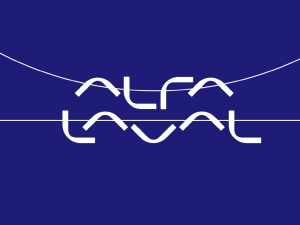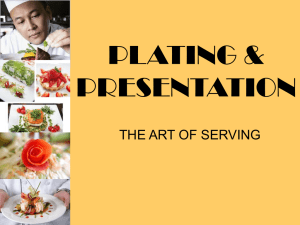COM KEY PROD Working principle of a PHE
advertisement
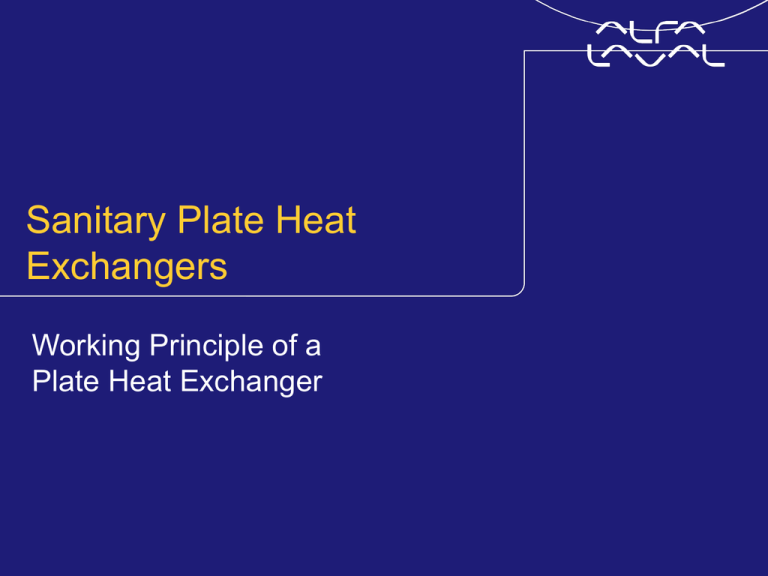
Sanitary Plate Heat Exchangers Working Principle of a Plate Heat Exchanger PHE - Main Components Carrying bar Frame plate Pressure plate Plate pack Tightening bolts © Alfa Laval Slide 2 www.alfalaval.com PHE - Dismantling © Alfa Laval Slideplay 3 Click on animation to again www.alfalaval.com Plate Heat Exchanger 360˚ turn © Alfa Laval Slide 4 www.alfalaval.com Plate Heat Exchanger inside © Alfa Laval Slide 5 www.alfalaval.com End Plate I Channel plates End Plate II Plate Pack - Example Single Pass Hot out Cold in Cold out Hot in Only 2 plates that do not transfer heat - the end plates © Alfa Laval Slide 6 www.alfalaval.com Plate Pack – Example Multipass Pass/Channel: Hot Side 2 x 4 Cold Side 2 x 4 Cold out Cold in Hot in Hot out © Alfa Laval Slide 7 www.alfalaval.com Applications In the Dairy • • • • • • Milk pasteurization Cream pasteurization Cultured milk treatment UHT Cheese milk heat treatment Ice cream mix heat treatment © Alfa Laval Slide 8 www.alfalaval.com Applications Pasteurization IP © Alfa Laval Slide 9 www.alfalaval.com Frame - purpose • Holds the plates together • Supports the plates (load / pressure) • Base for connections (inlet / outlet for media) © Alfa Laval Slide 10 www.alfalaval.com Frame - Types • Industrial types (mild steel, painted): FM, FG, FD Only used for utility (water heaters/coolers) • Hygienic types (stainless steel): Base, FMC, FHC, FRM, FRH, FRD, RM Normally used in the Food industry © Alfa Laval Slide 11 www.alfalaval.com Frame - > M15 and FrontLine™ Carrying bar • Unique 5-point alignment system – Provides exact positioning of the plates horizontally and vertically – Ensures good sealing throughout the plate pack Plate Guiding bar © Alfa Laval Slide 12 www.alfalaval.com FrontLine™ • Solid stainless steel frame and pressure plates • Cleaner since there is no risk of cracks in cladding allowing dirt and bacteria build-up • More durable since there is no internal mild steel structure that can corrode © Alfa Laval Slide 13 www.alfalaval.com FrontLine™ • Stainless steel bolts with ball bearing washers • Reduces service time © Alfa Laval Slide 14 www.alfalaval.com FrontLine™ • Bolt-in corners at connection plates • Easy to modify for new duties and applications © Alfa Laval Slide 15 www.alfalaval.com FrontLine™ Other Options • 3A polished fittings • • • • Connections in Titanium High legs Protection sheets Stainless steel bolt covers © Alfa Laval Slide 16 www.alfalaval.com Hygienic Frame - Connection Plate • Connection plates are used in multi–section units when one or more fluid must enter or leave the PHE at a location other than the frame or pressure plate. • Available as standard for types with hygienic frames – Front 10, Front 8, Front 6, Clip 3, M15, M10, M6, TL10B © Alfa Laval Slide 17 www.alfalaval.com Plates - Purpose • Create channels for the liquids (corrugation). • Create turbulence for the flow • Provides the heat transfer from one media to the other media. © Alfa Laval Slide 18 www.alfalaval.com The Channel Plate Construction • Plate pattern (L , M and H ) • Pressing depth • Clip and M plates B plates • Physical length and width of plate • Increase the number of passes © Alfa Laval Slide 19 www.alfalaval.com Plates Inlet / outlet Media 2 Inlet / outlet Media 1 Distribution area Fully supported gasket groove Heat transfer area Distribution area Inlet / outlet Media 1 Inlet / outlet Media 2 © Alfa Laval Slide 20 www.alfalaval.com Plate - Distribution Area • Chocolate pattern – Distributes flow evenly over the plate – Same P for distance A and B – Uses a minimum of P for distribution A – Gives more P for efficient heat transfer – Avoids dead spots in the far corner © Alfa Laval Slide 21 www.alfalaval.com Corner Guidance • First alignment made by the carrying & guiding bar • Corner guidance locks the plates in position and finetunes the alignment © Alfa Laval Slide 22 www.alfalaval.com Plate - Corrugation and Channels • We have two plate corrugations (L and H) • These form three different channels (L, M and H) H: High theta L: Low theta L + L = L channels L + H = M channels H + H = H channels • We choose between L, M and H channels • Tailor-made for the specific duty © Alfa Laval Slide 23 www.alfalaval.com Plate - corrugation and channels Low turbulence & pressure drop Medium turbulence & pressure drop High turbulence & pressure drop L + L = L channels L + H = M channels H + H = H channels Advantages Benefits • • • • • • • • Efficient heat transfer High wall shear stress Variable thermal length Strong construction © Alfa Laval Increased heat recovery Low fouling Optimal design Insensitive to vibration Slide 24 www.alfalaval.com The Plate Corrugation has two Functions: Mechanical – to make the plate rigid and provide interplate support points. Flow dynamic – to promote interplate fluid turbulence for high efficiency. Compact © Alfa Laval Slide 25 www.alfalaval.com Plate Pattern • • Herring bone Contact points – Mechanical Strength • Flow pattern – Cork screw – High turbulence © Alfa Laval Slide 26 www.alfalaval.com The Front Standard Plate • High and Low theta plates • Optimize the design for both thermal and product considerations © Alfa Laval Slide 27 www.alfalaval.com The Front Standard Plate • Deeper pressing depth • Ability to handle small particulates © Alfa Laval Slide 28 www.alfalaval.com The Front Standard Plate • Wide corrugations • Longer run times at same rate of fouling Clip plate Other unit © Alfa Laval Slide 29 www.alfalaval.com The Front Standard Plate • Five point alignment system • Ensures plate and gasket are aligned during take-up • Reinforced for frequent opening and closing © Alfa Laval Slide 30 www.alfalaval.com The Front Standard Plate • Long & narrow geometry • Even flow & heat transfer across plate surface • Low CIP flow rates © Alfa Laval Slide 31 www.alfalaval.com The Front Standard Plate • Flow distribution area • No “dead spots” for better hygiene • Promotes even flow across plate surface © Alfa Laval Slide 32 www.alfalaval.com The Front Standard Plate • Smaller port holes, tubing dimensions • Lower CIP flow rates, better hygiene © Alfa Laval Slide 33 www.alfalaval.com The Front Standard Plate • • • • Bright annealed finish Easier to clean Easier to inspect Higher corrosion resistance © Alfa Laval Slide 34 www.alfalaval.com Sanitary PHE Plate Design • Plate geometry (long & narrow) • Port holes • Distribution area • Stagnant areas • Pressing depth and corrugation • Plate surface Front standard plate Other plate •…to eliminate any risk for infection in pasteurisers © Alfa Laval Slide 35 www.alfalaval.com Plate Pack Assembly • • Channel Plate End Plate II (gasket against frame) • End plate I (metal against frame) • Turn Plate • Transition Plate • Partition Plate • Connection Plate End plate I End plate II © Alfa Laval Slide 36 www.alfalaval.com Plate Pack - Channel Plates • • • • Channel Plates are the heat transfer plates They dominate the plate pack Most frequently with 4 holes punched Alternating A / B (turned 180 degrees) © Alfa Laval Slide 37 www.alfalaval.com Plate Pack - End Plate I • In single pass, – Stops fluid at the end of the plate pack – Last plate at carbon steel pressure plate – No port holes are punched • In multi-pass, – Stops one fluid as it reaches the end – Allows other to flow into the plate pack – 2nd last plate in the plate pack (transition plate behind it) – Hole combination as per pass arrangement Normal gasket as on channel plates • • Usually in 0.6 mm with high-theta pattern © Alfa Laval Slide 38 www.alfalaval.com Plate Pack - Turning Plate • Used in multi-pass • 1, 2 or 3 port can be un-punched • Change the flow direction of one or both fluids in between the passes • Normal channel plate gasket © Alfa Laval Slide 39 www.alfalaval.com The Construction Number of plates depends on: • Flow rates • • • • • • Permitted pressure drops Temperature program Size & design of plates Heat recovery Material & thickness of plates Physical properties © Alfa Laval Slide 40 www.alfalaval.com Plate Pressing Single Step Pressing • Plates are totally uniform • Uniform metal-to-metal contacts points • Stronger plates that can handle – High pressure – High differential pressure – Vibrations © Alfa Laval Slide 41 www.alfalaval.com Plate - Pressing Depth • Alfa Laval has a range of pressing depths from 1.5 mm to 11 mm for optimal solution to any duty There is no good and no bad pressing depth. Just different ones to fit various duties Performance • pressure drop • heat recovery • compact design • gentle product treatment • special products • clogging problems Pressing depth © Alfa Laval Slide 42 www.alfalaval.com Plate - Parallel vs. Diagonal Flow Parallel flow advantages 180º • One plate & one gasket – Identical plates in plate pack – Rotated 180º to achieve both sides • Less spares required • Fully supported diagonal – Higher design pressure or thinner plate material • No crossing of nozzles © Alfa Laval Slide 43 www.alfalaval.com Plate - Materials • Standard materials and thicknesses • AISI 304 (stainless steel) • • • • © Alfa Laval - Usually 0.4 or 0.5 mm thick - Cheapest possible solution AISI 316 (stainless steel) - 0.5 and 0.6 mm thick - Some with thicker plates (high-pressure applications) 254 SMO (high-alloy stainless steel) - Usually in 0.6 mm to allow stock-keeping Titanium - 0.5 and 0.6 mm thick - Some with thicker plates (high-pressure applications) - Some with 0.4 mm (low-pressure applications) Alloy C-276 (Nickel alloy) - Usually in 0.6 mm to allow stock-keeping Slide 44 Relative Price 100% 115% 250% 300% 600% www.alfalaval.com Gaskets - Purpose • The purpose of the gaskets is to seal between the channel plates and between plates and the frame parts (connecting plate). • Are the only wear part (the ageing of rubber). © Alfa Laval Slide 45 www.alfalaval.com The Front Standard Plate • Glueless gasket • Gasket & plate work together as a system to replace adhesives • Less downtime, plates can be re-gasketed in frame © Alfa Laval Slide 46 www.alfalaval.com The Front Standard Plate • Deep gasket groove • Protection of gasket from elements • Higher pressure ratings • Ensures gasket remains on plate during opening © Alfa Laval Slide 47 www.alfalaval.com The Front Standard Plate • Thicker Gasket • Better resistance to thermal, pressure and CIP cycles • Longer gasket life © Alfa Laval Slide 48 www.alfalaval.com The Front Standard Plate • Twin gasket w/ leak detect ports • No chance for cross contamination across gaskets at port holes © Alfa Laval Slide 49 www.alfalaval.com Gasket - double sealing system Special venting ports are an integral part of the gasket design to prevent cross contamination If the gasket fails Leakage is detected on the outside © Alfa Laval Slide 50 www.alfalaval.com Gaskets - Standard Nitrile: • • • • NBRP = (performance) up to 110°C, Food grade NBRB = (base) inexpensive, lower temperature, Food grade NBRHTF = (high temperature) Food grade NBRFF = upgrade of NBRHTF Food grade Ethylene Propylene rubber: • EPDMC = clip-on/non-glued. High temperature (non food) • EPDMF = Food grade (FDA) • EPDFF = upgrade of EPDMF Food grade (FDA) (Not resistant to oil and fat) © Alfa Laval Slide 51 www.alfalaval.com Gasket - Profile and Groove Other Alfa Laval Profile Higher sealing pressure Risk of leakage. Groove Full support to gasket Openings. Risk of gasket blow-out. The difference is lifetime and reliability © Alfa Laval Slide 52 www.alfalaval.com Gasket - Sealing Lifetime Product Duty • Gasket material • Fastening • • • • – Glue or glue-free – Type of glue • Gasket geometry • Gasket groove • Alignment of plate pack Operating temperature Operating pressure Media Type of operation continuous / cyclic • Cleaning methods & chemicals • Opening frequency Life time! © Alfa Laval Slide 53 www.alfalaval.com Gasket - Sealing Lifetime • Maximum temperature in CAS and product manual (PMP), for example, – NBR up to 130ºC – EPDM up to 160ºC Gives about 1 year lifetime When no chemical attack takes place • Rule of thumb: – 10ºC lower than max temperature 2 years lifetime – 10ºC above the max temperature 6 months lifetime © Alfa Laval Slide 54 www.alfalaval.com PMP - Pressure/Temperature • A P/T graph can be made from data sheet information showing the expected performance of the plate & gasket – The design P/T should be inside the performance area – If P/T is on the line 1 year gasket lifetime – If P/T is outside Cannot guarantee the performance – If the gasket is chemically attacked more aspects to be added Limited by the max design pressure for the plate Pressure (barg) 25 Gasket lifetime limited by a combination of pressure and temperature 20 15 Performance area 10 5 Gasket lifetime limited by the max temperature 0 0 © Alfa Laval 50 100 TemperatureSlide (°C)55 150 www.alfalaval.com PMP - Pressure/Temperature • The data is found in the data sheet – In the gasket performance table • T(T) = The maximum allowed operating temperature. Above this temperature the gasket will last less than one year. • T(P) = Recommended temperature at max pressure. Higher pressure More strain on the gasket We cannot allow the max temperature – In the plate performance table • P(P) = Maximum design pressure for the plate. Above this pressure the plate will deform. • P(T) = Recommended max operating pressure at max operating temperature. © Alfa Laval Higher pressure Softer gasket 56 We cannot allow the maxSlidepressure www.alfalaval.com © Alfa Laval Slide 57 www.alfalaval.com
